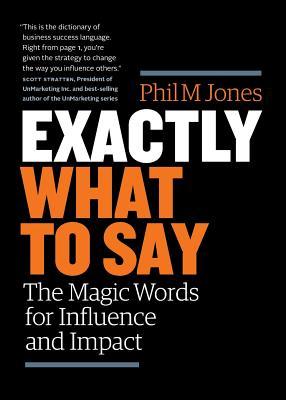
1 Line Summary
Exactly What to Say is a book about how to use the power of words to get what you want.
What Will You Learn
Here are some of the benefits of reading “Exactly What to Say”, you’ll learn how to:
- choose the right words to get your message across.
- build trust and influence others with your words.
- overcome objections and persuade others to your point of view.
- deliver presentations and speeches that are clear, concise and persuasive.
- communicate effectively in difficult situations.
Best Quotations from the Book
- “The way you frame a situation can have a big impact on how people react to it.”
- “The words you use can create a reality for the listener.”
- “The most important thing to remember is that the right words can change everything.”
- “The key to using the right words is to be aware of the power of your words and to choose them carefully.”
- “It’s not just what you say, but how you say it that matters.”
- “The wrong words can damage your relationships and derail your career.”
Book Summary
Control in a conversation, negotiation or debate is necessary to remain in a position of power. Phil Jones elaborates below mentioned psychological ways and the use of “magical words” for you, to be a center of attention in any situation:
How Would You Feel …
People work harder to avoid potential loss than achieving a potential gain. Using sentence like ”how would you feel” comprehended by a positive outcome proves out to be a reason to be moving towards a good news or away from a bad news.
How Open Minded Are You…
Everybody wants to be open-minded. Using sentence like “how open-minded are you” followed by a question compels people in a positive frame of mind.
I am Not Sure It’s For You But…
Using a sentence like “I am not sure it’s for you” followed by “but” leads conversation to a “Rejection free Approach” which eventually in two possible situations:
- listener either asks for more details or says,
- I will think over it.
Just Imagine…
Decisions are rather taken twice, first “hypothetically” then in “reality”. Using an expression like “just imagine” drives listener in possession of something hypothetical which most of the times leads to success.
When Will Be a Good Time …
Ideas fail to be heard because people won’t find time considering them; by saying a set of words like “when will be a good time” creates a picture.
It helps overcoming challenge of having a serious look into ideas, products or services.
I Bet You Are a Bit Like Me …
An expression like “I bet you are a bit like me” comfortably convinces anybody on anything.
If- Then Statements
Creating a scenario by using “if” and adding “then” usually means people are likely to believe the outcome.
Don’t Worry
An expression like “don’t worry” is used in high stress scenarios. It puts people at ease.
The Good News …
Prefacing things with “the good news is” causes people to face forward with optimism and zap negative energy out of conversation.
Most People …
Indecision is the biggest hurdle that stands in the way to progress. When you tell people “what most people do”, it gets them in positive frame of mind.
Before You Make Up Your Mind …
To move somebody from “No” to “Yes”, first thing is to move him from “No” to “May be”.
After successful shift from “No” to “May be” position, you achieved the power to remove barrier by responding with a powerful question that eliminates other person’s question.
What Do You Know About …
We sometimes meet people who tend to illuminate themselves by suppressing others; they possess “I Know Better” mentality. Questioning their source of knowledge by expression like “What Do You Know About” threatens their knowledge base and forces them to share their reference.
What Makes You Say That …
Success in negotiation is about maintaining control in conversation.
The person in control is the one who is constantly asking questions. Objections are tackled by being inquisitive.
Favor …
An expression like “Can You Do Me a Favor” creates open-mindedness, takes off pressure and leaves people in a positive frame of mind.
Question …
Questions shift control of conversation on one side. Below questions can entirely shift control in your favor:
- what specific do need to think about … ,
- what needs to happen for you to make a decision … ,
- what exactly is stopping you from moving forward with it right now …
Open Ended to Close Ended Questions …
Using simple swaps turn open ended questions to close ended ones, like:
- “any questions” can be swapped with “ what questions do you have from me?” OR
- “can I have your contact number” can be swapped with “on what number are you contacted?”
Give answers that simple, positive, effortless and uplifting and watch how they stun people into a positive decision.
If you want to be more persuasive, influential, and successful in your personal and professional life, then you need to read “Exactly What to Say”. This book will teach you how to use the power of words to get what you want.
For more insights, Click to Read “Creating Communications (Part 1)“, “Creating Communications (Part 2)“, “Tools for Talking When Stakes are High“, “How to Talk to Anyone“ ” Master the Art of Negotiation “,“How to Win Friends and Influence People” and “Relation between Effective Communication and Self Awareness“


Pingback: Book Summary: “The Power of Positive Relationships: How to Make Them Work for You” by Karen Reivich, Andrew Shatté
Pingback: “The 4 Disciplines of Execution” by Chris McChesney, Sean Covey, and Jim Huling Shortform Book Summary -
Pingback: “Crucial Conversations: Tools for Talking When Stakes Are High” -
Pingback: Negotiation: The Insights of Successful Negotiation Skills and Strategies -
Pingback: "Power of Positive Influence" by K. Blanchard: Book Summary
Pingback: How to Deliver a Memorable Presentation -
Pingback: “Trump: The Art of the Deal”by Donald Trump: Book Summary -
Pingback: “How to Talk to Anyone” by Leil Lowndes: Book Summary -
Pingback: “How to Win Friends and Influence People”: Book Summary -
Pingback: “Just Listen” by Mark Goulston: Book Summary -
Pingback: “Creating Communications”: Book Summary (Part-1) -
Pingback: “Creating Communications”: Book Summary (Part-2) -
Pingback: “Creating Communications”: Book Summary (Part-1) -
Pingback: “Crucial Conversations: Tools for Talking” : Book Summary -
Pingback: “Trump: The Art of the Deal”by Donald Trump: Book Summary »
Pingback: How to Deliver a Memorable Presentation »
Pingback: Negotiation: The Insights of Successful Negotiation Skills and Strategies »
Pingback: “The 360-Degree Leader” by John Maxwell: Book Summary »
Pingback: 14 Essential Traits of a Great Leader and How to Develop Them »